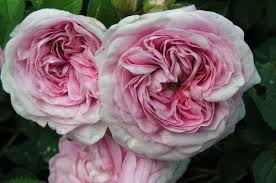What is an ‘Heirloom Rose’? Another appropriate name for an heirloom rose is “antique” or “old garden” roses, and this includes all roses that existed before 1867.
All classes of roses in existence before that time were deemed ‘old garden roses’ or ‘heirlooms’. Hence new classes were called modern roses. When I grew up in the south we called them "Grandmother Roses" No matter what name you call them these old variety roses to me are the best and hardest.
Unfortunately, they have been replaced by newer Hybrid and Floribunda roses. There is nothing wrong with the newer varieties, but if you were to grow them side by side you would choose the older and more fragrant heirloom rose.
The actual heirloom varieties are hard to pinpoint and fall into several categories; Albas, Centifolias, Damasks, Gallicas and Moss roses. These antique varieties are as simple to grow as the modern roses we find today. Admired for their fragrance and large beautiful blooms every garden should have a few.
Cardinal de Richelieu (Parmentier, 1847)
Gallicas are the oldest of the old garden roses, having been grown by the Greeks and Romans. Gallicas' have been involved in the development of all four other classes of ‘old garden roses’ and have influenced to at least some small degree nearly all garden roses down to the present. Galicia blooms come in some of the darkest, deepest purple of all roses their great colors range from shades of pink, reds, purples and even crimson- red with stripes. The single, double or semi-double blooms held either singly or in threes are mostly very fragrant. These roses can be grown in poor, even gravelly soil and demand a minimum of attention.
Portland Damask Rose 'Rose de Rescht'
The Damask rose dates back to Biblical times. DA roses are once bloomers, but more than make up for this deficit by their extraordinarily fragrant, perfume-like rose. Damasks have a mixed parentage originating from a natural hybrid between the Gallica rose and a wild species rose. Damasks are very cold hardy as some can be grown in zone 4. They are very thorny and have a rather lax and arching growth habit reaching three to seven feet tall. They require good fertile soil if they are to look their best.
Konigin Von Danemark (1826)
Fantin Latour (1836)
Centifolias are also known as ‘Cabbage Roses’ because of the size and shape of their blooms, along with many petals as the name suggests, up to 100 or more. They are the classic old garden roses often reproduced in artists’ prints popular today. Centifolias have lax, open, rather lanky growth with a mixture of large and small thorns. The leaves are large, rounded and broadly toothed while the flowers tend to be heavy and globular. They benefit from support to stop them bending too near the ground. They are once blooming very fragrant and very winter hardy.
Chapeau de Napoleon (1826)
The Moss Roses are the roses of Victorian England. Moss Roses are actually Centifolias and Damasks that have developed a distinctive, fragrant moss-like growth on the sepals that has the smell of pine. The mossing adds great elegance to the flowers and is a result of a sport, or fault in the plant. The majority of Moss Roses was bred over a short period of time, from approximately 1850 to 1870. Moss Roses have inherited the strong fragrance of their Centifolia ancestors and pruning should be as recommended for the Centifolias. Moss roses come in almost all colors and some varieties are repeat blooming.
Variegata di Bologna (1826)
Bourbon roses originated on the Île Bourbon (now called Réunion) off the coast of Madagascar in the Indian Ocean. They are believed to be the result of a cross between the Autumn Damask and the 'Old Blush' China rose, both of which were frequently used as hedging materials on the island. They are once bloomers that grow on vigorous, frequently semi-climbing shrubs with glossy foliage and purple-tinted canes.
Buff Beauty (1896)
The Hybrid Musk group was mainly developed by Rev. Joseph Pemberton, a British rosarian, in the first decades of the 20th century, based upon 'Aglaia', a 1896 cross by Peter Lambert. Hybrid musks are disease-resistant, repeat flowering and generally cluster-flowered, with a strong, characteristic "musk" scent. The stems tend to be lax and arching, with limited thorns. This is among my favorite Heirloom roses and I always have Buff Beauty and Cornelia somewhere in my garden. They grow the hardiest and bloom continuously.
Madame Alfred Carriere (1875)
The first Noisette rose was raised as a hybrid seedling by a South Carolina rice planter named John Champneys. Champneys sent seedlings of his rose (called 'Champneys' Pink Cluster') to his gardening friend, Philippe Noisette, who in turn sent plants to his brother Louis in Paris, who then introduced 'Blush Noisette' in 1817. The first Noisettes were small-blossomed, fairly winter-hardy climbers, but later infusions of Tea rose genes created a Tea-Noisette subclass with larger flowers, smaller clusters, and considerably reduced winter hardiness.
Reine Des Violettes (1838)
Hybrid Perpetuals, the dominant class of roses in Victorian England, (a misleading translation of hybrides remontants, 'reblooming hybrids') emerged in 1838 as the first roses which successfully combined Asian remontancy (repeat blooming) with the old European lineages. They became the most popular garden and florist roses of northern Europe at the time, as the tender tea roses would not thrive in cold climates, and the Hybrid Perpetuals' very large blooms were well-suited to the new phenomenon of competitive exhibitions. The "perpetual" in the name hints at repeat-flowering, but many varieties of this class had poor re-flowering habits; the tendency was for a massive spring bloom, followed by either scattered summer flowering, a smaller autumn burst, or sometimes nothing at all until next spring.











No comments:
Post a Comment
Please leave a comment or ask a gardening question.